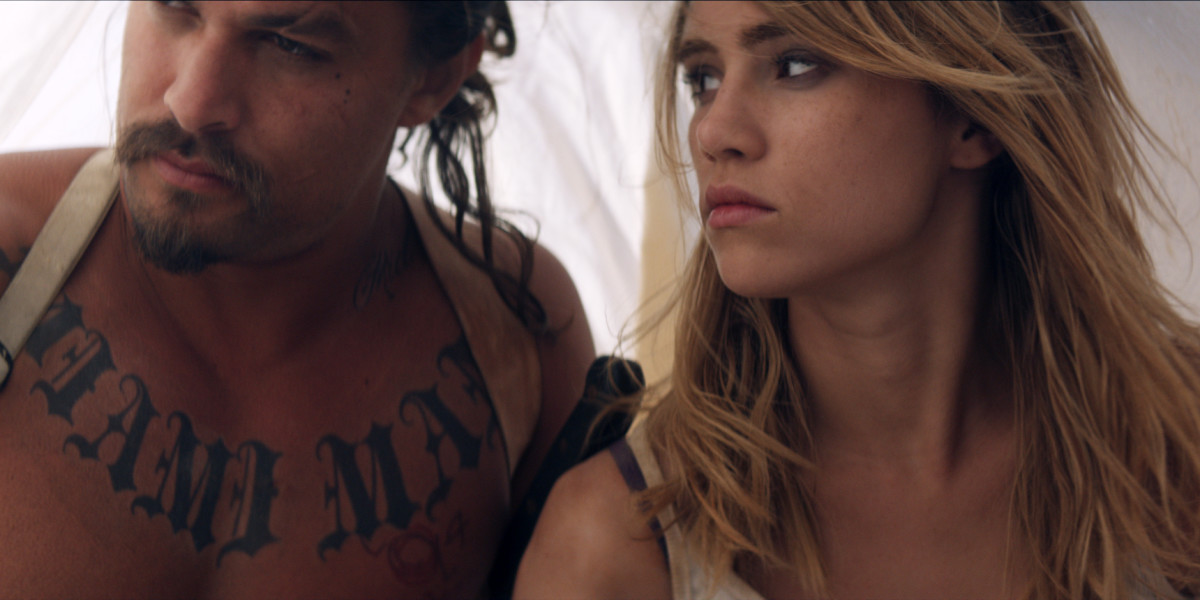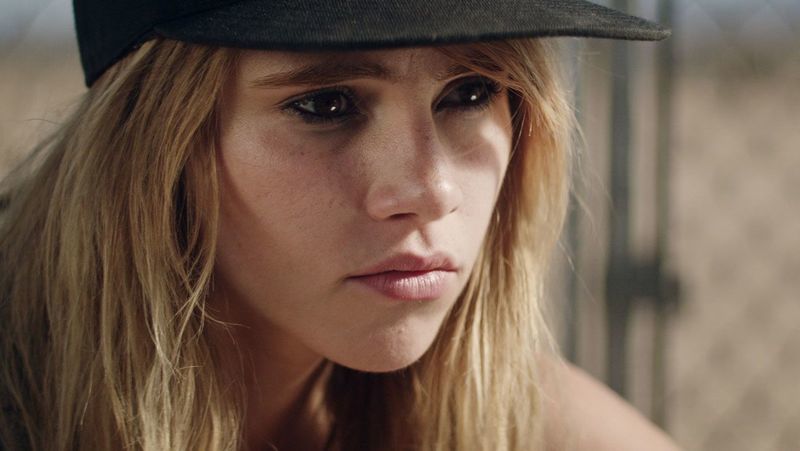“The Bad Batch” is Ana Lily Amirpour’s follow-up to her hugely successful Iranian vampire movie, “A Girl Walks Home Alone At Night.” This new cannibalistic western premiered at Venice and is now playing at TIFF, and it features a dystopian cordoned wasteland where the “bad batch”—individuals deemed unfit for society—are forced into exile and must fend for themselves in the Texan desert, with virtually no vegetation or food or water resources. Our gateway into this dangerous territory is the ever-curious teenage girl Arlen (Suki Waterhouse), who barely survives the human-flesh-eating Bridge People (among them, a hulky, silent, Jason Momoa) and discovers Comfort, a cult-like establishment where people reappropriate any flotsam and jetsam and debris to build a new sort of civilization. We talked to Amirpour about being in the Iranian diaspora, her refutation that “Bad Batch” is post-apocalyptic, and casting Jim Carrey as a dirty bearded man.
Salaam Lily! Welcome to “Tehranto”! We have the second-largest diaspora of Iranians outside of Tehrangeles.
Ana Lily Amirpour: Oh!
[We switch to Persian]
So you speak Farsi?
Yes a little! But very poorly.
[Back to English]
Amirpour: Yeah me too.
Were you surrounded by Persian people growing up?
Well yeah, don’t you feel like you’re always surrounded by some level of Persian people?
No. Actually I had the opposite experience. I grew up in Ottawa, which has a sizable Iranian population. But there was a snobbishness on the part of my parents against becoming friends with Iranian people, so I grew up really removed, really-
Westernized.
Yeah. Western. And removed from Iranian culture.
Yeah, me too. But I guess my family were always around.
They provide the connection to the culture.
Yeah. But we always had some Persian crew. But actually, I was the one who butted out. I wanted to just be American. Growing up, I was like, “I don’t want ghormeh sabzi! I want a hamburger. I want what the white people are doing. Can’t we just … ?”
Same. I was always trying to be white. My parents wanted to put me in Iranian school on Saturdays to learn the language, but my ballet class was at the same time. Obviously I’m going to choose dance over more schooling for a weird foreign language. Can you blame me?
Totally. No, you can’t.
So can you talk about how you came up with the ideas in the film?
It started in the summer of 2012 when I was editing “Girl.” I was going through a lot of savagely big life changes. I had this image of this girl in the middle of a desert missing an arm and a leg, and bleeding, but still alive and just grasping to go on. The rest of the world grew around this story, about how she would get cut up and have to reconstruct her own identity and figure out who she is.
There’s a lot of world building to establish the actual “bad batch” concept. This is basically a place where people presumably go to die, and then there are the concepts of finding Comfort and surviving the Bridge People. When did you decide on making them cannibals?
I’m attracted and interested in the outsider experience, the deviant experience, the non-conformers, the ideas that don’t fit neatly into the status quo. I don’t really think we live in one literal system. I think we’re always inside systems inside systems inside systems. Our relationships, the city, the culture, the politics, the religion, whatever. There are so many systems and some people like to pay attention to that and some people don’t. I really do.
In the wasteland new systems evolve organically between the Bridge People and the people at Comfort. They create their own worlds and civilizations in this post-apocalyptic world.
Actually I don’t think it’s post-apocalyptic. I think it’s now. Look at the world. I don’t think it’s that far-fetched. We do incredibly savage and horrible things to each other every single day for reasons much worse than hunger. Hunger is actually kind of an innocent, basic survival concept. What we do every day is so much more chaotic and senseless. You can’t wrap your mind around it. Human existence has always been like that.
That’s interesting. Did your ideas about this evolve over time as our collective societies have slowly deteriorated?
I’ve always viewed the world this way, philosophically. It’s how I feel in this world. But now it’s weirdly topical and suddenly this anti-Trump movie! I wrote it before any of this shit was happening so I guess it’s just a perk. Where do you put all these people who are deemed useless? It’s not just here. It’s in every country. The bad batch exist everywhere.

Let’s talk about Comfort.
We’re always defining what “comfort” is and pursuing it. That’s also part of human existence. I’ve always been uncomfortable with the idea of comfort. I start to feel like I’m deceiving myself.
I get the sense from your films that you actually want a bit of chaos.
I don’t know if I want it, but I definitely don’t want to pretend like it’s not there. I’m not comfortable without seeing what’s going on on the other side of the wall. Even if it’s harder and lonelier and maybe you don’t know exactly what’s going on out there but …
That is literally what Arlen does in the film. It’s terrifying!
[Jokingly] In the next film she won’t have any arms and legs!
Let’s talk about the pop-culture references in the film. Can you speak about the music choices, specifically “All That She Wants” and “Karmic Chameleon”?
Yeah, man. Music is a big part of designing a film for me. With this movie I wanted a couple of those really iconic pop songs because with the Bridge People and Muscle Beach, it had a feeling of the leftovers of ‘90s America: the scooters and golf carts and everything that was part of their world. Normally with my soundtracks I use smaller independent artists and put everything together myself. But for these two songs, they’re licensed by big companies and it’s expensive. The budget was not limitless. So it was tricky. We had to find the right songs for those scenes. When we avoid looking at what we’re doing to each other, to avoid the gnarly reality, we turn up the music. It’s this idea of not paying attention to get through it. It’s nice to breathe new life into these songs. Ace of Base will never be the same way.
It was admittedly a little traumatizing. Regarding Jim Carrey, whom you can’t even recognize in his get-up: I thought of his performance art at the MTV Awards in the ‘90s when nobody even recognized who he was. It’s very convincing in “Bad Batch.”
And how great is it to experience an actor like that? Because he wants that. All actors want that, they want to disappear and when you’re that famous—he’s Jim fucking Carrey—you can’t disassociate who he is. Carrey’s character is like the homeless dirty guy who everyone ignores on every street corner. When you’re that famous for however many decades, people don’t really see you. So it’s like two sides of the same coin. There’s this real connection there for him with this invisibility and who he’s playing in the movie, being the kind, gentle soul inside of all the chaos. I really like character design and collaborating with all of the actors—what they’re going to wear, what they’re like physically. And he’s so into that. That’s his own beard. He got really really dirty. It took hours of makeup. He went all in. Grew his nails [laughs].
I was also reminded of the “Matrix” movies when Arlen finally has her sit-down with the “Dream” cult leader, played by Keanu Reeves, when he’s talking quite, uh, eloquently about human feces. It’s like the scenes where Neo first meets the Oracle and the Architect. It’s these wise characters who will provide vital information and sage advice. Now the roles are reversed for Keanu.
I love “The Matrix.” All these movies we love are part of our DNA. And I’ve loved Keanu since I was a kid. And as sinister as all those things around him may be, there’s something safe about it, too. You know, you wouldn’t mind joining his crew … !
Can you describe your decision to move away from the Iranian themes (from your first film) in “The Bad Batch”?
It’s not about choosing a theme. It’s about where I’m at, what I feel, what I need to get out, and how that’s going to come out. It’s all personal. The first film is very personal, and it’s about my own experience of loneliness. That movie started with the chador, because I put it on one day and I was riding a skateboard and I thought of this character and how loneliness manifests into that story. “The Bad Batch” is different. It’s about how this girl goes on after she’s been ripped apart. So the next one will be whatever it needs to be, too.

